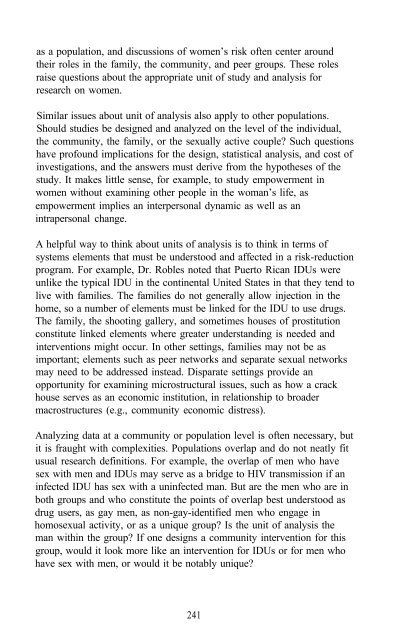The Context of HIV Risk Among Drug Users and Their Sexual Partners
The Context of HIV Risk Among Drug Users and Their Sexual Partners
The Context of HIV Risk Among Drug Users and Their Sexual Partners
You also want an ePaper? Increase the reach of your titles
YUMPU automatically turns print PDFs into web optimized ePapers that Google loves.
as a population, <strong>and</strong> discussions <strong>of</strong> women’s risk <strong>of</strong>ten center around<br />
their roles in the family, the community, <strong>and</strong> peer groups. <strong>The</strong>se roles<br />
raise questions about the appropriate unit <strong>of</strong> study <strong>and</strong> analysis for<br />
research on women.<br />
Similar issues about unit <strong>of</strong> analysis also apply to other populations.<br />
Should studies be designed <strong>and</strong> analyzed on the level <strong>of</strong> the individual,<br />
the community, the family, or the sexually active couple? Such questions<br />
have pr<strong>of</strong>ound implications for the design, statistical analysis, <strong>and</strong> cost <strong>of</strong><br />
investigations, <strong>and</strong> the answers must derive from the hypotheses <strong>of</strong> the<br />
study. It makes little sense, for example, to study empowerment in<br />
women without examining other people in the woman’s life, as<br />
empowerment implies an interpersonal dynamic as well as an<br />
intrapersonal change.<br />
A helpful way to think about units <strong>of</strong> analysis is to think in terms <strong>of</strong><br />
systems elements that must be understood <strong>and</strong> affected in a risk-reduction<br />
program. For example, Dr. Robles noted that Puerto Rican IDUs were<br />
unlike the typical IDU in the continental United States in that they tend to<br />
live with families. <strong>The</strong> families do not generally allow injection in the<br />
home, so a number <strong>of</strong> elements must be linked for the IDU to use drugs.<br />
<strong>The</strong> family, the shooting gallery, <strong>and</strong> sometimes houses <strong>of</strong> prostitution<br />
constitute linked elements where greater underst<strong>and</strong>ing is needed <strong>and</strong><br />
interventions might occur. In other settings, families may not be as<br />
important; elements such as peer networks <strong>and</strong> separate sexual networks<br />
may need to be addressed instead. Disparate settings provide an<br />
opportunity for examining microstructural issues, such as how a crack<br />
house serves as an economic institution, in relationship to broader<br />
macrostructures (e.g., community economic distress).<br />
Analyzing data at a community or population level is <strong>of</strong>ten necessary, but<br />
it is fraught with complexities. Populations overlap <strong>and</strong> do not neatly fit<br />
usual research definitions. For example, the overlap <strong>of</strong> men who have<br />
sex with men <strong>and</strong> IDUs may serve as a bridge to <strong>HIV</strong> transmission if an<br />
infected IDU has sex with a uninfected man. But are the men who are in<br />
both groups <strong>and</strong> who constitute the points <strong>of</strong> overlap best understood as<br />
drug users, as gay men, as non-gay-identified men who engage in<br />
homosexual activity, or as a unique group? Is the unit <strong>of</strong> analysis the<br />
man within the group? If one designs a community intervention for this<br />
group, would it look more like an intervention for IDUs or for men who<br />
have sex with men, or would it be notably unique?<br />
241
















